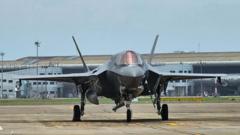A state-of-the-art British F-35B fighter jet that had been stranded at Thiruvananthapuram Airport in India for over five weeks has finally departed for Australia. The aircraft, which is part of the fleet associated with the HMS Prince of Wales, encountered bad weather during a sortie in the Indian Ocean on June 14, prompting its diversion to the Indian airport. Soon after landing, the jet developed a technical snag that led to its prolonged stay, raising eyebrows and sparking curiosity about how a modern aircraft could remain idle in a foreign country for such an extended period.
The British naval aircraft was towed to a Maintenance Repair and Overhaul facility at the airport, where engineers aimed to diagnose and resolve the issues. Despite their efforts, the initial attempts by onboard engineers were unsuccessful. Consequently, the UK Ministry of Defence deployed a team of 14 engineers to assist with the repairs at the facility. Just days before its departure, the aircraft was declared fit to fly, and it took off for Darwin, Australia, as confirmed by an airport spokesperson.
The situation also caught the attention of the House of Commons, where discussions regarding the stranded aircraft and its logistical implications took place. The incident generated a mix of speculation and humor, with images of the "lonely F-35B" amid Kerala's monsoon rains becoming fodder for memes, as commenters humorously suggested that the aircraft was reluctant to leave the scenic region known as "God's own country." The jet's eventual successful departure not only marked the resolution of a logistical challenge but also spotlighted the complexities surrounding military aviation and cross-border operations in contemporary conflict settings.




















